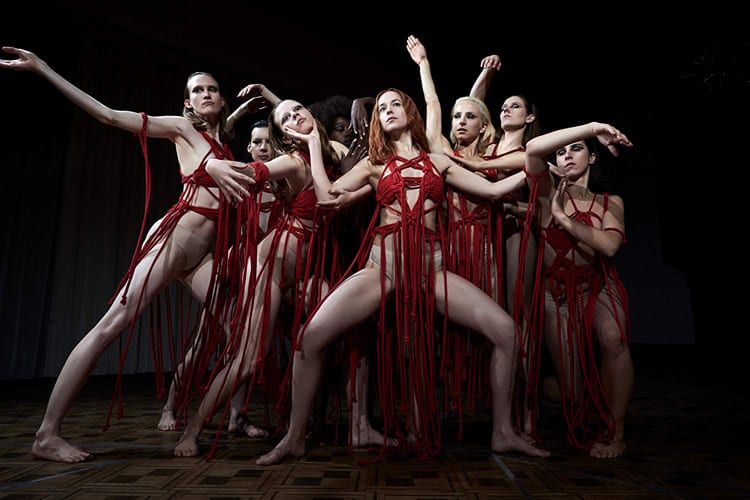The film industry could teach humankind a lesson on recycling. We live in an age of remakes and reboots—recently, there have been three separate versions of Spider-Man over nine years, two different reboots of “The Jungle Book” three years apart, and two adaptations of Stephen King novels that were already adapted thirty years ago. It’s refreshing, then, when filmmakers put an entirely new spin on existing material. The 2018 version of “Suspiria” offers something fresh: it’s more homage than a remake.
The original “Suspiria”, written and directed by Italian horror maestro Dario Argento in 1977, is frequently cited as one of the best horror films of all time. It follows an American woman named Suzy who travels to Freiburg, Germany to join a dance academy. Though she originally finds friends and purpose there, things go awry when she finds out that the academy is run by a coven of witches. 2018’s version—directed by Luca Guadagnino of “Call Me by Your Name” fame—has roughly the same set-up, but the rest of the movie stands on its own narratively. Guadagnino, evidently inspired by the original, takes a few of its central ideas and develops quite a different movie.
From the outset, Guadagnino’s style diverges from Argento’s. “Suspiria” 1977 was awash in vibrant, primary colors, while “Suspiria” 2018 is coated in dust and darker hues. The cinematography of “Suspiria” 1977 starkly highlighted gore against its colorful backgrounds; the camera of “Suspiria” 2018 wanders through halls of horror like a curious, freewheeling eye. The atmospheric score of the original—courtesy of Italian prog-rock band Goblin—is swapped out for an ominous score from Thom Yorke, the frontman of Radiohead. Visually and sonically, this new “Suspiria” is less eclectic and distinctive than its forebearer, but its lower-key approach builds a subtler sense of dread.
Guadagnino takes the opposite approach with the symbology of “Suspiria”. The 2018 reimagining borrows suggestive symbols from the 1977 version and brings them to the thematic forefront. “Suspiria” 2018 is interested in parallelism from the start: it moves the dance academy to Berlin and establishes the year as 1977, ostensibly so that it can draw comparisons between its witch story and the German Autumn, a season of terror attacks from a far-left German group fighting the West German government. The coven that runs Markos Dance Academy is dealing with its own civil war, as Madame Blanc (Tilda Swinton) and Mother Markos (also Tilda Swinton) battle for leadership over the witches.
The backdrop of the German Autumn, exposited via news and far-off explosions, is a reminder of the classic cinematic depictions of masculine violence: intrusions and eruptions. Guadagnino seizes the corresponding images of feminine victimhood—being entered or pierced—and subverts them into terrifying symbols of feminine violence. The passive act of being entered becomes the active power of subsuming, as the witches use dance to possess and literally embody. The witches trade knives—long the phallic representations of masculine piercing—for hooks, sharp weapons that violently draw in rather than thrusting away. “Suspiria” 2018 is replete with psychosexual symbolism that Guadagnino cuts together into frightening shapes.
The narrative, unfortunately, is more ostentatious than evocative. Never is this clearer than in the subplot of Dr. Josef Klemperer (Tilda Swinton a third time), a psychoanalyst who crosses paths with some of the academy’s dancers. A remarkable amount of this two-and-a-half hour movie is dedicated to Klemperer, which wouldn’t be so bad if his role culminated in something profound. “Suspiria” uses him to address male disbelief in women, male guilt, and how male violence begets female violence—but it takes a long time to say very little about any of those things. Klemperer ends up convoluting the plot more than anything.
When the doctor’s interactions with the Marcos Dance Academy reach a climax, “Suspiria” should reach a zenith of disturbance, but Guadagnino’s directorly tendencies get in the way. The movie’s most brutal scene belongs to its first act: that moment is shot head-on, shoving grotesque imagery down our throats with minimal flourish. Guadagnino stamps his energetic style all over the third act’s centerpiece moment, though, drowning otherwise horrific events in distracting sweeps and embellishments. It’s a shame—the movie’s finale would’ve been magnificent if done right. Whenever Guadagnino falters, one wonders what “Suspiria” might’ve been if the feminine tale were directed by a woman.
This offering is still worthwhile, though. It frequently feels like a could’ve-been masterpiece that misses a few too many of its marks. The pieces are still fascinating, and even if they don’t come together perfectly, there’s still plenty here for horror hounds to chew on.
★★★½ (3.5/5)




